Naples is a city where history intertwines with modern life, where past and present coexist in layers as rich and intricate as its cuisine. Beneath its bustling streets lies another world—dark, mysterious, and filled with echoes of the past. If October’s spooky season has you in the mood for adventure tinged with chills, there’s no better place to explore than the catacombs underneath Naples. These underground wonders aren’t just passages of stone; they are a gateway to a hidden history, alive with stories of faith, death, and resilience.
In this guide, we’ll take you beneath the sunlit surface and into the silent heart of Naples, exploring the catacombs that have made this city legendary.
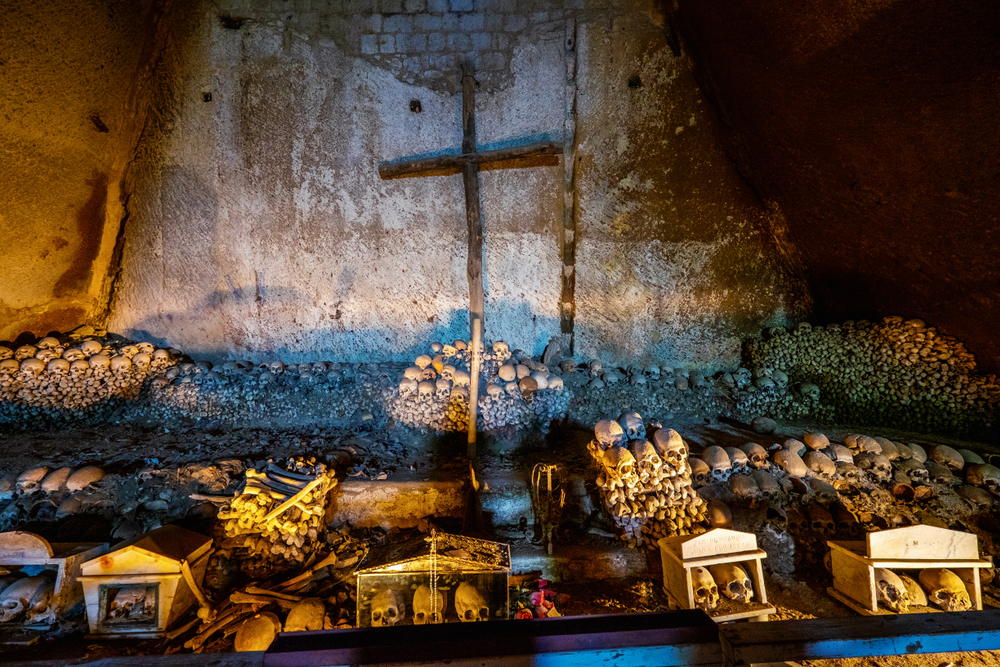
A subterranean journey: the hidden history of Naples
Naples is a city full of life and energy—but beneath its bustling streets lies an entirely different world. The catacombs of Naples are more than just underground tunnels; they represent a journey into the very core of Neapolitan history. These catacombs began as burial grounds during the early days of Christianity when the city’s first believers needed a safe space to practice their faith and lay their loved ones to rest.
The Catacombs of San Gennaro and the Catacombs of San Gaudioso are the two most famous, each offering a unique glimpse into Naples’ layered past. They are full of intricate frescoes, solemn tombs, and hidden chambers that carry the weight of centuries. Exploring them is like stepping back in time, surrounded by history that’s literally carved into the stone.
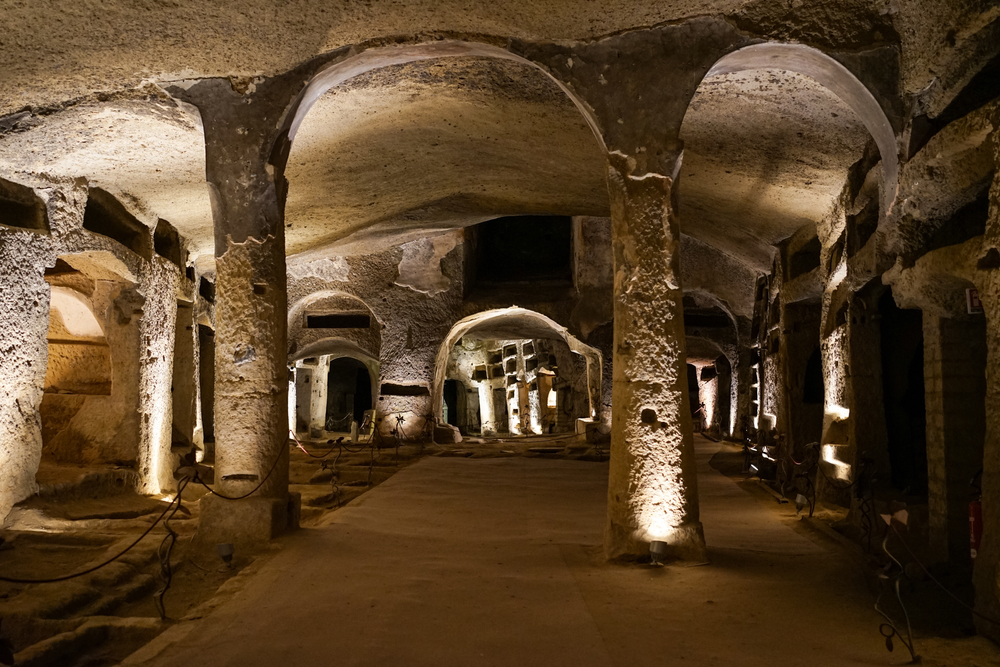
The Catacombs of San Gennaro: a spiritual descent
The Catacombs of San Gennaro, named after Naples’ beloved patron saint, are the largest and perhaps the most historically significant catacombs in the city. Located beneath Capodimonte Hill, these catacombs are divided into two levels, each with fascinating features that tell the story of a growing Christian community and their evolving customs.
- A Network of Sacred Chambers: the catacombs are made up of a series of chambers and passageways that feel like an underground basilica. The ceilings are surprisingly high, creating an airy feeling even though you are beneath layers of earth. This sense of spaciousness sets them apart from the more cramped catacombs found in Rome.
- Ancient Origins: these catacombs date back to the 2nd century AD, when Christianity was still a new and often persecuted faith. The lower level is a maze of burial niches called loculi and family tombs, while the upper level is where the artwork shines.
- A feast for the eyes: the upper level features stunning early Christian frescoes and mosaics, some dating to the 3rd and 4th centuries. These depict biblical scenes, symbols like the anchor and fish, and portraits of early bishops. One of the highlights is a fresco of the Virgin Mary with the Child—one of the oldest such depictions in the region.
- The Tomb of San Gennaro: although the actual remains of San Gennaro have been moved, his original tomb still draws many visitors. The catacombs have a sacred atmosphere, filled with symbols of devotion and hope, and exploring them is an emotional experience—connecting you directly with the faith of the early Neapolitans.
- Fun Fact: the catacombs were carved from soft volcanic rock called tuff. This rock is what has allowed the ancient frescoes to remain vibrant, even after all these centuries!
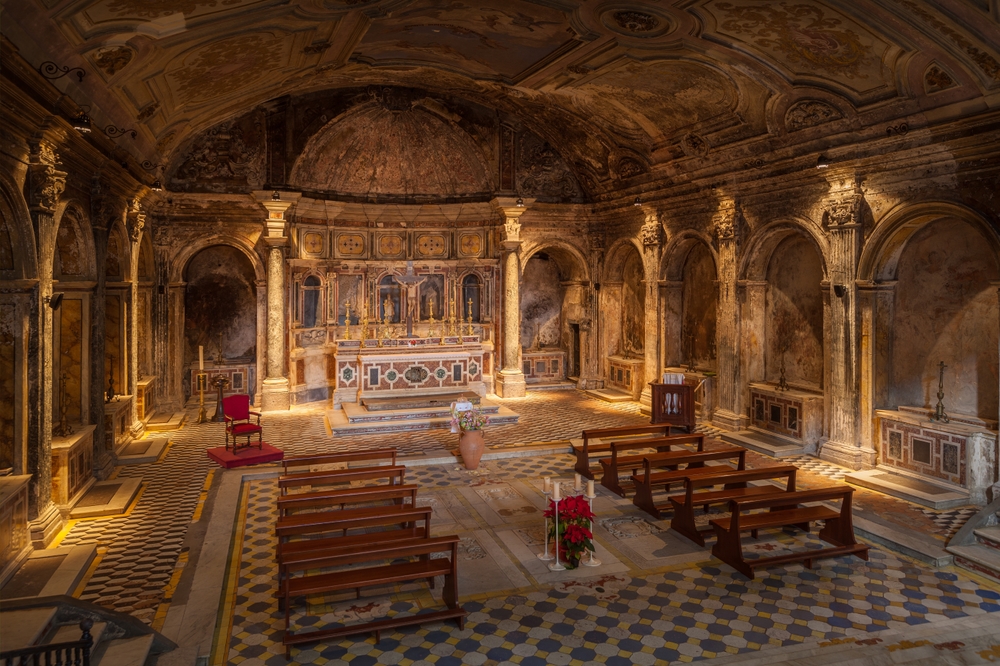
The Catacombs of San Gaudioso: where life and death converge
While San Gennaro might be more well-known, the Catacombs of San Gaudioso have their own unique mystique. Located beneath the Basilica of Santa Maria della Sanità, these catacombs reflect a fascinating blend of early Christian and later Baroque elements, showcasing the evolving customs around death and burial in Naples.
- The Origins of San Gaudioso: this catacomb is named after Saint Gaudioso, a North African bishop who settled in Naples after being exiled in the 5th century. He chose this site for his burial, and it soon became a place of honor for early Christians and, later, for Neapolitan nobility.
- An eerie twist on burials: during the 17th century, a unique burial custom emerged here. Skulls of the deceased were embedded into the walls, while their bodies were painted below, often depicting scenes from their lives. These painted figures celebrated the earthly accomplishments of the dead, making them part of the very architecture. Fun Fact: one of the paintings shows a doctor, with his skull placed above an illustration of his body, complete with his surgical tools. It’s like an eerie underground portrait gallery where life and death intertwine!
- Art that spans centuries: the catacombs also contain frescoes from the 5th and 6th centuries that depict Christian symbols, such as the Chi-Rho (a Christogram) and the fish symbol (Ichthys), alongside the later, more elaborate Baroque elements. This blend of styles makes the catacombs not just a burial place but also a unique art gallery that spans different periods of Neapolitan history.
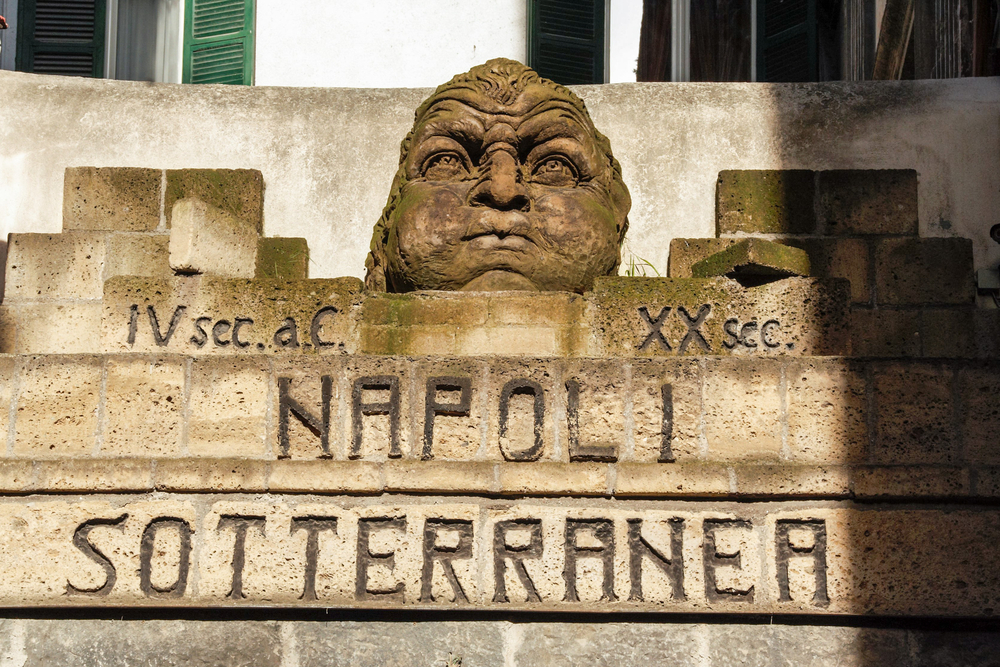
Exploring the hidden details of Naples’ Catacombs
As you wander through the catacombs, take your time to notice the many fascinating details that add depth to the experience:
- Symbols and meanings: keep an eye out for carvings of anchors (symbolizing hope), vines (representing spiritual growth), and doves (symbols of peace). These small carvings tell the story of early Christian beliefs and their hope for eternal life.
- Cubicula and the wealthy: the catacombs feature small, private rooms called cubicula. These rooms were used by wealthy families and adorned with beautiful frescoes that celebrated their faith. They were like mini chapels, designed to reflect the transition to the afterlife as something bright and hopeful.
- Fun Fact: early Christians believed that death was merely a step towards eternal life, which is why so many of the frescoes are vibrant and full of hope, even in these underground tombs.
- Repurposed Roman columns: the catacombs feature columns that were originally part of ancient Roman buildings. This reuse of Roman materials illustrates how the early Christians adapted what they could find to build their sacred spaces, blending the old with the new.
The Atmosphere of the Catacombs: sacred and spooky!
Exploring these catacombs isn’t just about seeing burial niches and ancient art; it’s about experiencing the atmosphere. The catacombs are quiet and cool, with a sense of timelessness that envelops you the moment you step inside.
- Sacred silence: the stillness in the catacombs makes it easy to imagine the rituals and prayers that took place here centuries ago. It’s an intimate connection to the past, where you feel surrounded by the echoes of those who walked these halls before you.
- Perfect for October: visiting during October gives the catacombs an extra layer of intrigue. The chill of the underground chambers, combined with the fading autumn light above, makes it feel like a real-life Halloween experience—filled with history rather than horror, yet still tinged with just enough eeriness to give you chills.
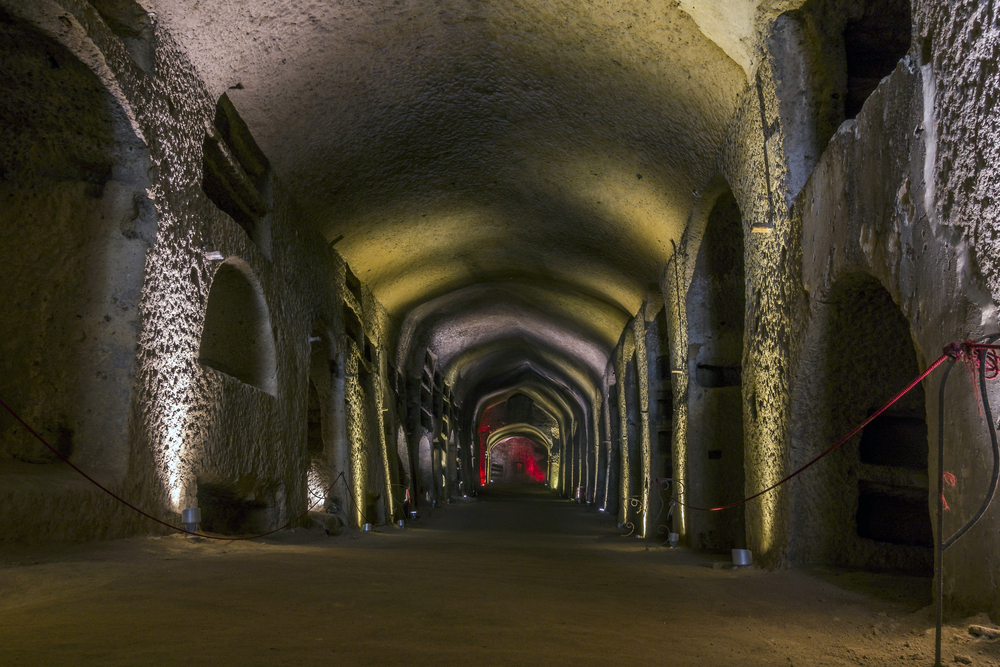
Why visit the Catacombs? An adventure beyond the ordinary
Above ground, Naples is lively, colorful, and bursting with energy, but below the surface, it’s reflective, sacred, and a bit chilling. It’s the perfect place for those who want to see beyond the typical sights and feel a deeper connection to the city.
The catacombs also offer a quiet escape from the hustle and bustle of Naples, which can feel overwhelming at times. There’s something about descending into the earth, into the quiet gloom, that makes you feel as if you’ve stepped outside of time. You are suddenly surrounded by stories of lives lived long ago, and the presence of those who carved out these spaces with their bare hands.
And, of course, October adds its own unique flavor to a catacomb visit. With the air turning crisp and the days getting shorter, a tour of Naples’ subterranean wonders can feel like an extended Halloween experience: a blend of cultural enrichment and a gentle chill down your spine.
Practical tips for Exploring Naples’ Catacombs
If you’re planning to venture into the catacombs, here are a few practical tips to make the most of your journey:
- Wear comfortable shoes: the catacombs involve quite a bit of walking on uneven surfaces. Comfortable, sturdy shoes are essential to ensure you can navigate the passageways without discomfort.
- Bring a sweater: even during the warmer months, the catacombs remain cool and slightly damp. A light sweater or jacket will keep you comfortable as you explore the depths of Naples.
- Check opening Hours and availability: the catacombs can have restricted hours, especially in the off-season, so it’s best to check their schedules in advance. You can easily book tickets online for either San Gennaro or San Gaudioso, and sometimes a combined ticket can offer a better value.
- Respect the Sacred Nature: while they are a popular tourist attraction, the catacombs are still sacred spaces. Many of the areas are places of rest and worship, so remember to act with the appropriate level of respect—lowered voices, no flash photography, and a respectful demeanor are all part of the experience.
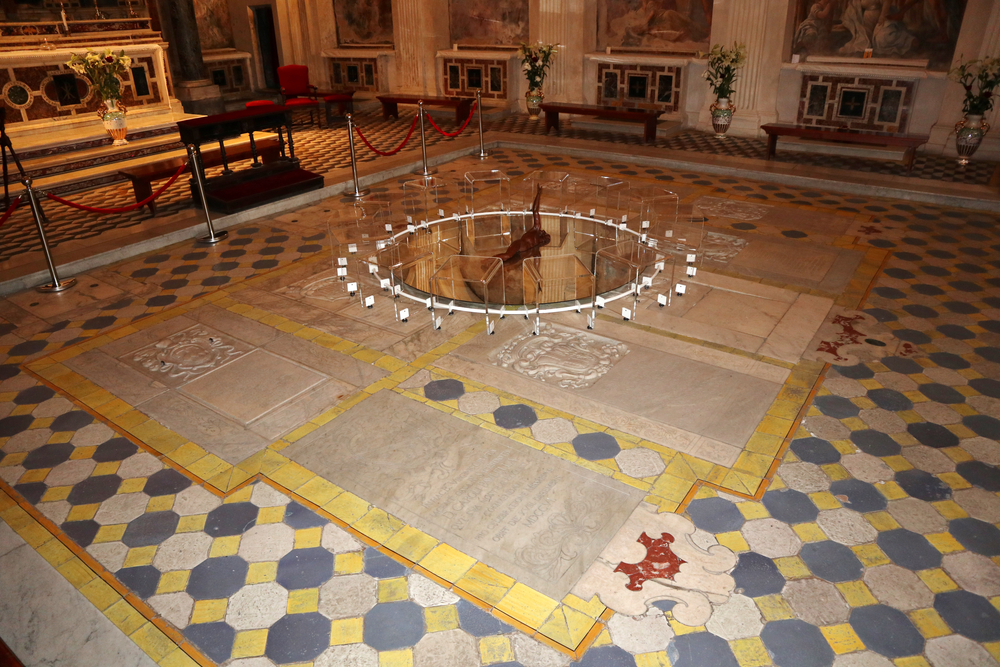
Beyond the Catacombs: other spooky sites in Naples
If your appetite for the eerie hasn’t been quite satisfied, Naples offers even more sites that are steeped in mystery. Consider visiting the Fontanelle Cemetery, another underground marvel filled with the bones of thousands of plague victims, or take a walk through the Chiesa del Purgatorio ad Arco, a church dedicated to souls in purgatory, complete with an underground hypogeum where Neapolitans once practiced unique rituals to care for the souls of the dead.
There’s also the mysterious Sansevero Chapel, home to the chillingly beautiful sculpture known as the Veiled Christ, along with several other anatomical models that hint at secretive 18th-century experiments. This combination of art, science, and mysticism makes it one of the most hauntingly beautiful places in the city.
Explore Sorrento and the Amalfi Coast with Iamme Ia!
Who better to help you navigate this area than Iamme Ia!, your expert companion. Connecting with us is easy. For more information on our tours, to make bookings, or to discuss your upcoming travel plans, please visit our tour pages or contact page on our website.
If you find yourself wandering the charming streets of Sorrento, feel free to stop by our office at Piazza Torquato Tasso 16, where our friendly staff is eager to help you plan your next unforgettable adventure. As a proud Gray Line licensee, Iamme Ia! has been committed since 2014 to not only showcasing the stunning landscapes and rich culture of the Amalfi Coast but also to providing a narrative that weaves together breathtaking views, diverse experiences, and memorable moments.
With Iamme Ia!, your journey through Italy will be more than just a visit—it will be a profound engagement with the heart and soul of the region. Let us turn your trip into an experience of a lifetime.
Remember to join our Instagram community for some extra fun content!
Have your say - Leave a comment below: